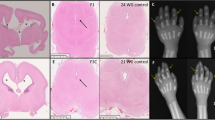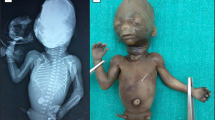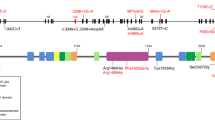Abstract
ANENCEPHALY, spina bifida and related midline neurological defects are among the commonest severe congenital malformations in man for which a specific aetiology is still unknown. The deformities frequently occur together or in close relatives and, although their prevalence rates vary widely in different populations1 and have shown impressive secular trends within populations2, the rates are highly correlated, a fact which suggests a common aetiology. There is a well established recurrence risk of 4–5 per cent following the birth of the first affected child in a sibship, and for this reason a genetic aetiology has long been considered likely. No evidence for increased parental consanguinity has been found, and polygenic inheritance has in the past usually been accepted as the most satisfactory explanation for the known facts3. In 1968, however, Yen and MacMahon concluded that the recurrence risk for anencephaly and spina bificla could not be genetically determined because in none of 105 twin pairs taken from their own studies and other consecutive series in the literature was concordance for either deformity observed4. Furthermore, these authors noted that the recurrence risk for maternal half-siblings appeared to be as great as that for full siblings, an observation which they felt was inconsistent with genetic determination. As an alternative hypothesis, Yen and MacMahon suggested that the recurrence risk, variation in population frequencies and observed secular trends may all be attributable to an unidentified environmental factor. The twin data are, however, as difficult to reconcile with environmental causation as they are with either monogenic or polygenic Mendelian inheritance, because individual variation in the observed response to external teratogenie influences, be they environmental or maternal, must also arise, at least in part, from genetic differences in exposed foetuses. In either case, a high concordance rate might be expected among identical twins.
This is a preview of subscription content, access via your institution
Access options
Subscribe to this journal
Receive 51 print issues and online access
$199.00 per year
only $3.90 per issue
Buy this article
- Purchase on Springer Link
- Instant access to full article PDF
Prices may be subject to local taxes which are calculated during checkout
Similar content being viewed by others
References
Stevenson, A. C., Johnson, H. A., Stewart, M. I. P., and Golding, D. R., Bull. World Health Org., 34, 1 (1966).
Naggan, L., Amer. J. Epidem., 89, 154 (1969).
Carter, C. O., Laurence, K. M., and David, P. A., Dev. Med. Child Neurol., 9, 30 (1967).
Yen, S., and MacMahon, B., Lancet, ii, 623 (1968).
Falconer, D. S., Ann. Hum. Genet., 29, 51 (1965).
Falconer, D. S., Ann. Hum. Genet., 31, 1 (1967).
Carter, C. O., David, P. A., and Laurence, K. M., J. Med. Genet., 5, 81 (1968).
Stern, C., Principles of Human Genetics (2nd edition), 533 (W. H. Freeman and Co., San Francisco, 1960).
Wagner, R. P., Science, 163, 1026 (1969).
Williamson, E. M., J. Med. Genet., 2, 161 (1965).
Carter, C. O., and Fraser Roberts, J. A., Lancet, i, 306 (1967).
Emery, A. E. H., University of Edinburgh Inaugural Lecture No. 35 (April 29, 1968) (T. and A. Constable, Ltd, Edinburgh).
Allen, G., Prog. in Medical Genet., 4, 242 (1965).
Zuelzer, W. W., Beattie, K. M., and Reisman, L. E., Amer. J. Hum. Genet., 16, 38 (1964).
Kennedy, J. F., and Donahue, R. P., Lancet, i, 754 (1969).
Nance, W. E., Davies, J., and Chazen, E., Clin. Res., 17, 316 (1969).
Storrs, E. E., and Williams, R. J., Proc. US Nat. Acad. Sci., 60, 910 (1968).
Penrose, L. S., J. Ment. Defic. Res., 1, 4 (1957).
Sonneborn, T. M., in Heritage from Mendel (edit. by Brink, R. A.), 375 (Univ. Wise. Press, Madison, 1967).
Curtis, A. S. G., Arch. Biol. (Liège), 76, 523 (1965).
Author information
Authors and Affiliations
Rights and permissions
About this article
Cite this article
NANCE, W. Anencephaly and Spina Bifida: a Possible Example of Cytoplasmic Inheritance in Man. Nature 224, 373–375 (1969). https://doi.org/10.1038/224373a0
Received:
Revised:
Issue Date:
DOI: https://doi.org/10.1038/224373a0
This article is cited by
-
Manifestation of carcinogenesis as a stochastic process on the basis of an altered mitochondrial genome
Archiv f�r Toxikologie (1981)
-
Anencephalus and spina bifida: An ecological approach
Human Ecology (1976)
-
Genetic variability of human plasma and erythrocyte lipids
Lipids (1971)
-
Sex ratio in spina bifida and anencephaly
Genetica (1971)
-
The sex ratio in anencephaly
Genetica (1970)
Comments
By submitting a comment you agree to abide by our Terms and Community Guidelines. If you find something abusive or that does not comply with our terms or guidelines please flag it as inappropriate.



